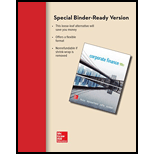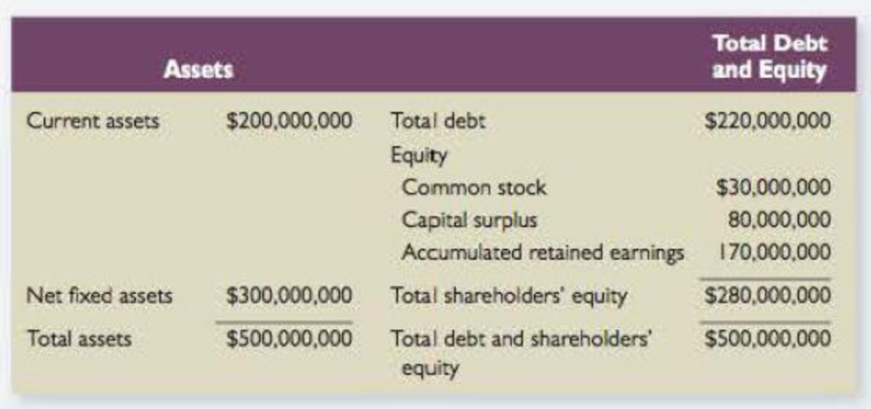
Loose Leaf for Corporate Finance (Mcgraw-hill/Irwin Series in Finance, Insurance, and Real Estate)
11th Edition
ISBN: 9781259709685
Author: Stephen A. Ross Franco Modigliani Professor of Financial Economics Professor, Randolph W Westerfield Robert R. Dockson Deans Chair in Bus. Admin., Jeffrey Jaffe
Publisher: McGraw-Hill Education
expand_more
expand_more
format_list_bulleted
Textbook Question
Chapter 15, Problem 7QP
Financial Leverage Harrison, Inc., has the following book value balance sheet:

a. What is the debt-equity ratio based on book values?
b. Suppose the market value of the company’s debt is $225 million and the market value of equity is $670 million. What is the debt-equity ratio based on market values?
c. Which is more relevant, the debt-equity ratio based on book values or market values? Why?
Expert Solution & Answer
Want to see the full answer?
Check out a sample textbook solution
Students have asked these similar questions
Assume Bismuth Electronics has a book value of $6 billion of equity and a face value of $19.7 billion of debt. The market values of equity and debt are $2.5 billion and $18.5 billion. A Wall Street financial analyst determines values of equity and debt as $3 billion and $20 billion. Which of the following values should be used for calculating the firm's WACC?
A) $6 billion of equity and $19.7 billion of debt
B) $2.5 billion of equity and $20 billion of debt
C) $3 billion of equity and $19.9 billion of debt
D) $2.5 billion of equity and $18.5 billion of debt
Assume Lavender Corporation has a market value of $4 billion of equity and a market value of $19.8 billion of debt. What are the weights in equity and debt that are used for calculating the WACC?
The basic WACC equation
The calculation of WACC involves calculating the weighted average of the required rates of return on debt, preferred stock, and common equity, where the weights equal the percentage of each type of financing in the firm’s overall capital structure.
is the symbol that represents the cost of preferred stock in the weighted average cost of capital (WACC) equation.
Raymond Co. has $1.4 million of debt, $3 million of preferred stock, and $1.2 million of common equity. What would be its weight on debt?
0.59
0.25
0.49
0.21
Chapter 15 Solutions
Loose Leaf for Corporate Finance (Mcgraw-hill/Irwin Series in Finance, Insurance, and Real Estate)
Ch. 15 - Bond Features What are the main features of a...Ch. 15 - Prob. 2CQCh. 15 - Preferred Stock Preferred stock doesnt offer a...Ch. 15 - Preferred Stock and Bond Yields The yields on...Ch. 15 - Prob. 5CQCh. 15 - Call Provisions A company is contemplating a...Ch. 15 - Prob. 7CQCh. 15 - Preferred Stock Do you think preferred stock is...Ch. 15 - Long-Term Financing As was mentioned in the...Ch. 15 - Internal versus External Financing What is the...
Ch. 15 - Prob. 11CQCh. 15 - Classes of Stock Several publicly traded companies...Ch. 15 - Callable Bonds Do you agree or disagree with the...Ch. 15 - Bond Prices If interest rates fall, will the price...Ch. 15 - Sinking Funds Sinking funds have both positive and...Ch. 15 - Prob. 1QPCh. 15 - Prob. 2QPCh. 15 - Prob. 3QPCh. 15 - Prob. 4QPCh. 15 - Financial Leverage Kiedis, Corp., has...Ch. 15 - Financial Leverage Frusciante, Inc., has 290,000...Ch. 15 - Financial Leverage Harrison, Inc., has the...Ch. 15 - Valuing Callable Bonds KJC, Inc., plans to issue 5...Ch. 15 - Valuing Callable Bonds New Business Ventures,...Ch. 15 - Valuing Callable Bonds Bowdeen Manufacturing...Ch. 15 - Prob. 11QPCh. 15 - Prob. 12QP
Knowledge Booster
Learn more about
Need a deep-dive on the concept behind this application? Look no further. Learn more about this topic, finance and related others by exploring similar questions and additional content below.Similar questions
- Whirlpool manufactures and sells home appliances under various brand names. IBM develops and manufactures computer hardware and offers related technology services. Target operates a chain of general merchandise discount retail stores. The data in the following table apply to these companies (dollar amounts in millions). For each firm, assume that the market value of the debt equals its book value. REQUIRED a. Assume that the intermediate-term yields on U.S. government Treasury securities are 3.5%. Assume that the market risk premium is 5.0%. Compute the cost of equity capital for each of the three companies. b. Compute the weighted-average cost of capital for each of the three companies. c. Compute the unlevered market (asset) beta for each of the three companies. d. Assume that each company is a candidate for a potential leveraged buyout. The buyers intend to implement a capital structure that has 75% debt (with a pretax borrowing cost of 8.0%) and 25% common equity. Project the weighted-average cost of capital for each company based on the new capital structure. To what extent do these revised weighted-average costs of capital differ from those computed in Requirement b?arrow_forwardAssume Skyler Industries has debt of $4,500,000 with a cost of capital of 7.5% and equity of $5,500,000 with a cost of capital of 10.5%. What is Skylers weighted average cost of capital?arrow_forwardThe Rivoli Company has no debt outstanding, and its financial position is given by the following data: What is Rivoli’s intrinsic value of operations (i.e., its unlevered value)? What is its intrinsic stock price? Its earnings per share? Rivoli is considering selling bonds and simultaneously repurchasing some of its stock. If it moves to a capital structure with 30% debt based on market values, its cost of equity, rs, will increase to 12% to reflect the increased risk. Bonds can be sold at a cost, rd, of 7%. Based on the new capital structure, what is the new weighted average cost of capital? What is the levered value of the firm? What is the amount of debt? Based on the new capital structure, what is the new stock price? What is the remaining number of shares? What is the new earnings per share?arrow_forward
- Financial leverage Costco Wholesale Corporation (COST) and Wel-Mart Stroes Inc. (WMT)reported the following data (in milllions) for a recent year: Compute the return on stockholders equity. Round to one decimal place.arrow_forwardUsing the Du Pont method, evaluate the effects of the following relationships for the Butters Corporation. a. Butters Corporation has a profit margin of 5 percent and its return on assets (investment) is 22.5 percent. What is its assets turnover? (Round your answer to 2 decimal places.) b. If the Butters Corporation has a debt-to-total-assets ratio of 55.00 percent, what would the firm's return on equity be? (Input your answer as a percent rounded to 2 decimal places.) c. What would happen to return on equity if the debt-to-total-assets ratio decreased to 50.00 percent? (Input your answer as a percent rounded to 2 decimal places.)arrow_forwardThe following data pertains to Xena Corp. Xena Corp. Total Assets $21,249 Interest-Bearing Debt (market value) $11,070 Average borrowing rate for debt 10.2% Common Equity: Book Value $5,535 Market Value $23,247 Marginal Income Tax Rate 19% Market Beta 1.64 A. Using the information from the table, and assuming that the risk-free rate is 4.5% and the market risk premium is 6.2%, calculate Xena's cost of equity capital, using the capital asset pricing model: B. Using the information from the table, determine the weight on debt capital that should be used to calculate Xena's weighted-average cost of capital.arrow_forward
- Suppose your firm has a market value of equity is $500 million and a market value of debt is $475 million. What are the capital structure weights (i.e., weight of equity and weight of debt)? Group of answer choices A) weight of equity is 51.28%, , weight of debt is 48.72% B) weight of equity is 48.72%, , weight of debt is 51.28% C) weight of equity is 47.62%, , weight of debt is 52.38%arrow_forwardUsing the DuPont method, evaluate the effects of the following relationships for the Butters Corporation. A.Butters Corporation has a profit margin of 5.5 percent and its return on assets (investment) is 8.75 percent. What is its assets turnover? Round your answer to 2 decimal places. ______ times B.If the Butters Corporation has a debt-to-total-assets ratio of 65.00 percent, what would the firm’s return on equity be? Note: Input your answer as a percent rounded to 2 decimal places. C.What would happen to return on equity if the debt-to-total-assets ratio decreased to 60.00 percent? Input your answer as a percent rounded to 2 decimal places.arrow_forwardCan you explain the information below market value added (MVA) analysis and interpretation of results below. Market Value of Equity:$133,341,000,000.00 Plus: Market Value of Debt:$13,677,000.00 Equals: Market Value of Firm:$133,354,677,000.00 Minus: Total Invested Capital:($1,944,100.00) Equals: MVA$133,356,621,100.00arrow_forward
- Garwryk, inc., which is finance with debt and equity, presently has a debt ratio of 78 percent. What is the firm’s equity multiplier? How is the equity multiplier related to the firm’s use of debt financing (i.e., if the firm increased its use of debt financing would this increase or decrease its equity multiplier)? Explain What is the firm’s multiplier? The equity multiplier is given by: Equity multiplier =1 1-debt ratio The equity multiplier is Round to two decimal placesarrow_forwardYou are analyzing the leverage of two firms and you note the following (all values in millions of dollars): a. What is the market debt-to-equity ratio of each firm? b. What is the book debt-to-equity ratio of each firm? c. What is the interest coverage ratio of each firm? d. Which firm will have more difficulty meeting its debt obligations? a. What is the market debt-to-equity ratio of each firm? The market debt-to-equity ratio for Firm A is enter your response here . (Round to two decimal places.) Part 2 The market debt-to-equity ratio for Firm B is enter your response here . (Round to two decimal places.) Part 3 b. What is the book debt-to-equity ratio of each firm? The book debt-to-equity ratio for Firm A is enter your response here . (Round to two decimal places.) The book debt-to-equity ratio for Firm B is enter your response here . (Round to two decimal places.) Part 5 c. What is the interest coverage ratio of each firm? The interest coverage ratio for Firm A is enter…arrow_forwardYou have the following data for your company. Market Value of Equity: $520 Book Value of Debt: $130 Required rate of return on equity: 12% Required rate of return on debt (pre-tax): 7% Corporate tax rate: 25% The company's debt is assumed to be is reasonably safe, so the book value of debt is a reasonably approximation for the market value of debt. What is the weighted average cost of capital for this company?arrow_forward
arrow_back_ios
SEE MORE QUESTIONS
arrow_forward_ios
Recommended textbooks for you
 Survey of Accounting (Accounting I)AccountingISBN:9781305961883Author:Carl WarrenPublisher:Cengage Learning
Survey of Accounting (Accounting I)AccountingISBN:9781305961883Author:Carl WarrenPublisher:Cengage Learning
 EBK CONTEMPORARY FINANCIAL MANAGEMENTFinanceISBN:9781337514835Author:MOYERPublisher:CENGAGE LEARNING - CONSIGNMENT
EBK CONTEMPORARY FINANCIAL MANAGEMENTFinanceISBN:9781337514835Author:MOYERPublisher:CENGAGE LEARNING - CONSIGNMENT- Principles of Accounting Volume 2AccountingISBN:9781947172609Author:OpenStaxPublisher:OpenStax College
 Financial Reporting, Financial Statement Analysis...FinanceISBN:9781285190907Author:James M. Wahlen, Stephen P. Baginski, Mark BradshawPublisher:Cengage Learning
Financial Reporting, Financial Statement Analysis...FinanceISBN:9781285190907Author:James M. Wahlen, Stephen P. Baginski, Mark BradshawPublisher:Cengage Learning

Survey of Accounting (Accounting I)
Accounting
ISBN:9781305961883
Author:Carl Warren
Publisher:Cengage Learning


EBK CONTEMPORARY FINANCIAL MANAGEMENT
Finance
ISBN:9781337514835
Author:MOYER
Publisher:CENGAGE LEARNING - CONSIGNMENT

Principles of Accounting Volume 2
Accounting
ISBN:9781947172609
Author:OpenStax
Publisher:OpenStax College

Financial Reporting, Financial Statement Analysis...
Finance
ISBN:9781285190907
Author:James M. Wahlen, Stephen P. Baginski, Mark Bradshaw
Publisher:Cengage Learning
Financial ratio analysis; Author: The Finance Storyteller;https://www.youtube.com/watch?v=MTq7HuvoGck;License: Standard Youtube License